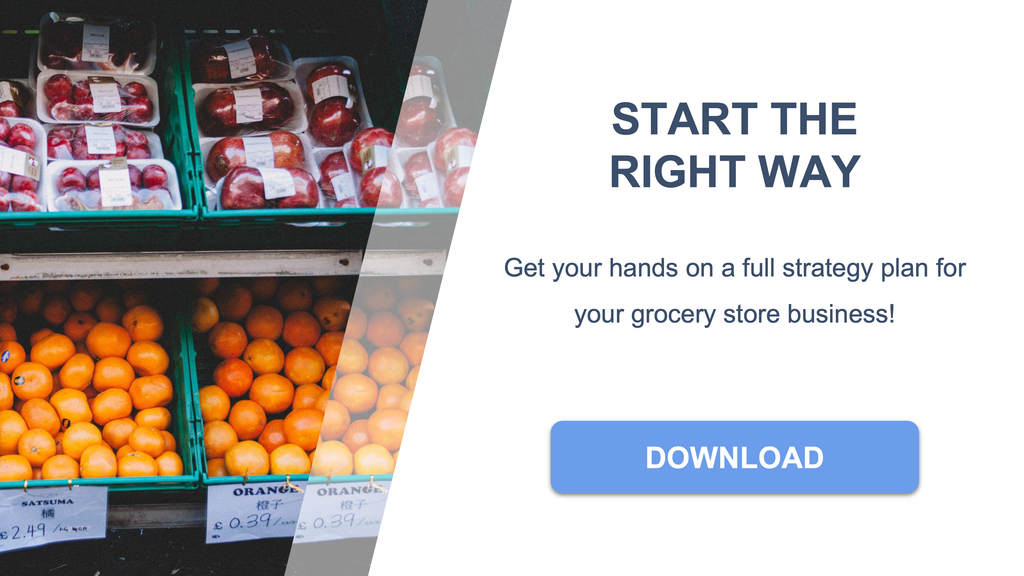This article was written by our expert who is surveying the industry and constantly updating the business plan for a grocery store.

Opening a grocery store requires substantial capital investment across multiple areas, from securing prime retail space to stocking comprehensive inventory.
The total startup costs range dramatically based on store size and location, with small neighborhood stores requiring $25,000-$50,000 while larger operations can exceed $1 million in initial investment.
If you want to dig deeper and learn more, you can download our business plan for a grocery store. Also, before launching, get all the profit, revenue, and cost breakdowns you need for complete clarity with our grocery store financial forecast.
Starting a grocery store involves significant upfront investments and ongoing operational expenses that vary greatly by location and store size.
Entrepreneurs must carefully budget for property costs, equipment, inventory, staffing, and working capital to ensure successful launch and sustainability.
| Cost Category | Investment Range | Key Details |
|---|---|---|
| Total Startup Budget | $25,000 - $1,000,000+ | Small stores: $25k-$50k, Mid-sized: $80k-$300k, Large/specialty: $400k-$1M+ |
| Property (Rent/Purchase) | $3,000-$50,000/month | Varies by location, size (80-650 sqm), and foot traffic potential |
| Renovation & Equipment | $33,000-$70,000 | Includes refrigeration ($18k-$28k), shelving ($5k-$15k), renovation ($10k-$25k) |
| Initial Inventory | $30,000-$250,000 | Baseline stock for opening, specialty stores may require $50k+ |
| Monthly Staffing | $25,000-$40,000 | 10+ employees including cashiers, stockers, and management |
| Monthly Utilities | $4,500-$5,000 | Heavy refrigeration needs drive electricity costs significantly higher |
| Cash Reserve (6-12 months) | $150,000-$300,000 | Critical for covering operating expenses during ramp-up period |

What is the total estimated startup budget required to open a grocery store?
The total startup budget for a grocery store ranges from $25,000 to over $1 million, depending on the store size, location, and business model you choose.
Small mom-and-pop neighborhood stores typically require $25,000 to $50,000 in initial investment. These operations focus on basic essentials and serve local communities with minimal overhead costs. Mid-sized grocery stores need substantially more capital, ranging from $80,000 to $300,000 to accommodate larger inventory, more sophisticated equipment, and expanded product offerings.
Large grocery stores and specialty markets represent the highest investment tier, often exceeding $1 million in startup costs. Gourmet and specialty stores specifically require around $400,000 due to premium product sourcing, specialized equipment, and upscale store design requirements. The significant variation in costs stems from factors like prime location premiums, store square footage, refrigeration needs, and target market positioning.
You'll find detailed market insights in our grocery store business plan, updated every quarter.
What are the average rental or property purchase costs for a retail space suitable for a grocery store?
Grocery store rental costs vary dramatically by location, with monthly rent ranging from $3,000 to $50,000 for spaces between 80 to 650 square meters.
In Bangkok, Thailand, retail spaces suitable for grocery stores cost between ฿30,000 to ฿650,000 per month (approximately $857 to $18,571 at current exchange rates). These prices reflect the wide range of available locations, from suburban neighborhood spots to prime commercial districts with high foot traffic.
In the United States, comparable grocery store spaces command $3,000 to $50,000 monthly rent, while property purchases range from $500,000 to $2 million depending on location and size. Prime locations in high-traffic areas typically cost 30% to 40% more than secondary locations, but they offer significantly higher customer volume and revenue potential.
The key consideration is balancing location costs with expected foot traffic and sales volume, as prime real estate can justify higher rents through increased revenue generation.
How much is typically spent on store renovation, shelving, refrigeration units, and display equipment?
Store renovation and equipment costs for grocery stores typically range from $33,000 to $70,000, with refrigeration representing the largest single expense category.
| Equipment Category | Cost Range | Detailed Specifications |
|---|---|---|
| Basic Renovation | $10,000 - $25,000 | Includes lighting upgrades, flooring installation, layout modifications, and basic electrical work |
| Premium Renovation | $50,000 - $500,000+ | Comprehensive remodeling with custom design, high-end fixtures, and specialized grocery features |
| Commercial Refrigeration | $18,000 - $28,000 | 3-5 commercial refrigeration units including walk-in coolers, display cases, and installation costs |
| Shelving Systems | $5,000 - $15,000 | Adjustable metal gondola systems, end caps, produce displays, and specialty racks |
| POS Hardware | $300 - $2,500 | Cash registers, barcode scanners, receipt printers, and payment processing equipment |
| POS Software | $15 - $399/month | Inventory management, sales tracking, and customer management systems |
| Additional Equipment | $5,000 - $15,000 | Shopping carts, security systems, weighing scales, and storage solutions |
What is the expected cost of the initial inventory to stock the store at opening?
Initial inventory costs for grocery stores range from $30,000 to $250,000, depending on store size, product mix, and target market positioning.
Baseline inventory for a standard grocery store opening typically requires $30,000 to $50,000 to stock essential items across all major categories including produce, dairy, meat, packaged goods, and household items. This covers approximately 2,000 to 3,000 different SKUs needed for a basic grocery operation.
Specialty and ethnic grocery stores often require higher initial inventory investments of $50,000 or more due to specialized product sourcing, imported items, and unique supplier relationships. Larger format stores serving broader communities may need $100,000 to $250,000 in opening inventory to fill extensive shelf space and provide comprehensive product selection.
Smart inventory management involves negotiating favorable payment terms with suppliers, starting with core essentials, and gradually expanding product lines based on customer demand patterns and sales data.
What are the estimated licensing, permits, and legal fees involved in setting up a grocery store?
Licensing, permits, and legal fees for grocery store setup typically cost between $3,000 and $15,000, covering business registration, food handling permits, and regulatory compliance.
Basic business registration and licensing fees range from $3,000 to $8,000 in most jurisdictions, including business license, reseller permits, and basic legal structure setup. Food safety certifications and health department permits add another $1,000 to $5,000 to ensure compliance with food handling regulations and local health codes.
Additional permits may include zoning compliance, fire department approvals, building permits for renovations, and alcohol licenses if selling beer and wine. Legal fees for contract review, lease negotiations, and business structure optimization typically add $2,000 to $5,000 to the total setup costs.
This is one of the strategies explained in our grocery store business plan.
What is the monthly payroll cost, including hiring cashiers, stockers, and potentially a store manager?
Monthly payroll costs for grocery stores typically range from $25,000 to $40,000 for a team of 10 to 15 employees, including management, cashiers, and stock personnel.
| Position | Number of Staff | Monthly Salary Range | Total Monthly Cost |
|---|---|---|---|
| Store Manager | 1 | $4,500 - $7,000 | $4,500 - $7,000 |
| Assistant Manager | 1 | $3,000 - $4,500 | $3,000 - $4,500 |
| Cashiers | 4-6 | $550 - $750 each | $2,200 - $4,500 |
| Stock Personnel | 4-6 | $625 - $875 each | $2,500 - $5,250 |
| Produce Specialist | 1-2 | $650 - $900 each | $650 - $1,800 |
| Deli/Bakery Staff | 1-2 | $600 - $800 each | $600 - $1,600 |
| Part-time Support | 2-4 | $400 - $600 each | $800 - $2,400 |
What are the projected monthly utility bills, such as electricity, water, and internet?
Monthly utility costs for grocery stores range from $4,500 to $5,000, with electricity representing the largest expense due to extensive refrigeration and lighting requirements.
Electricity costs typically account for $3,000 to $4,000 monthly due to commercial refrigeration units, freezers, lighting systems, and HVAC needs. Refrigeration alone can consume 40% to 60% of total electricity usage in grocery operations. Water costs average $200 to $300 monthly for cleaning, produce preparation, and general operations.
Internet and telecommunications services cost approximately $150 to $250 monthly for high-speed connections supporting POS systems, inventory management, and customer WiFi. Additional utilities like waste management and security monitoring add $300 to $500 monthly to operational costs.
Energy-efficient LED lighting and Energy Star-certified refrigeration equipment can reduce utility costs by 20% to 30%, providing significant long-term savings on operational expenses.
How much should be allocated to marketing and advertising during the launch phase and in the first year?
Marketing and advertising budgets for grocery store launches should represent 10% to 15% of total startup capital, with launch campaigns ranging from $5,000 to $50,000 depending on market size and competition.
Initial launch marketing typically requires $5,000 to $15,000 for neighborhood grocery stores, covering grand opening promotions, local advertising, and community outreach programs. Mid-sized stores in competitive markets need $15,000 to $30,000 for broader advertising campaigns, digital marketing, and promotional pricing strategies.
Large format stores and specialty markets may invest $30,000 to $50,000 in comprehensive marketing campaigns including radio, print advertising, social media marketing, and promotional events. Ongoing monthly marketing budgets typically range from $1,000 to $5,000 for sustained customer acquisition and retention efforts.
Effective grocery store marketing focuses on location awareness, competitive pricing communication, and building community relationships through local partnerships and sponsorships.
What is the cost of insurance coverage, including general liability, product liability, and property insurance?
Comprehensive insurance coverage for grocery stores costs between $150 and $500 monthly, depending on store size, inventory value, and coverage levels required.
Basic Business Owner's Policy (BOP) coverage starts at approximately $87 monthly and includes general liability and property insurance for smaller grocery operations. This covers customer injuries, property damage, and basic business interruption protection essential for retail food operations.
Product liability insurance is crucial for grocery stores due to food safety concerns and typically adds $50 to $150 monthly to insurance costs. Workers' compensation insurance ranges from $100 to $300 monthly depending on staff size and state requirements. Comprehensive coverage including cyber liability, equipment breakdown, and expanded business interruption protection can reach $400 to $500 monthly.
Insurance costs vary significantly based on location, crime rates, natural disaster risks, and claims history, making it essential to obtain multiple quotes from specialized commercial insurance providers.
How much capital is needed as a cash reserve for the first 6 to 12 months to cover operating expenses before the store becomes profitable?
Cash reserves of $150,000 to $300,000 are typically needed to cover 6 to 12 months of operating expenses while the grocery store builds customer base and achieves profitability.
The cash reserve calculation should cover monthly rent ($3,000-$50,000), payroll ($25,000-$40,000), utilities ($4,500-$5,000), insurance ($150-$500), and ongoing inventory replenishment costs. Most grocery stores require 6 to 9 months to reach break-even point, making adequate cash reserves critical for survival during the ramp-up period.
Conservative planning suggests maintaining 12 months of operating expenses in reserve, particularly for stores in competitive markets or those introducing new concepts to their communities. This provides buffer for unexpected challenges, seasonal fluctuations, or longer-than-anticipated customer acquisition periods.
We cover this exact topic in the grocery store business plan.
What is the cost of a Point-of-Sale (POS) system, including hardware, software, and maintenance?
POS system costs for grocery stores range from $300 to $2,500 for hardware plus $15 to $399 monthly for software, depending on transaction volume and feature requirements.
Basic POS hardware including cash register, barcode scanner, receipt printer, and card reader costs $300 to $800 for single-station setups. Multi-station systems for larger stores require $1,500 to $2,500 in hardware investment. Software costs vary significantly based on features, with basic systems starting at $15 monthly and comprehensive grocery-specific solutions reaching $399 monthly.
Grocery-specific POS systems include inventory management, supplier integration, produce weighing functionality, and customer loyalty programs. Cloud-based solutions typically cost less upfront but have ongoing monthly fees, while traditional systems require higher initial investment but lower ongoing costs.
Annual maintenance and support costs add 10% to 20% of initial hardware costs, covering technical support, software updates, and equipment repairs necessary for reliable daily operations.
How much should be budgeted for logistics and transportation of goods from suppliers to the store, especially if cold chain is involved?
Logistics and transportation costs typically represent 5% to 10% of inventory costs, with cold chain requirements adding an additional 15% to 25% premium for temperature-controlled products.
Standard grocery delivery costs range from $50 to $200 per delivery depending on distance, order size, and frequency. Stores requiring daily deliveries for fresh products may spend $1,500 to $6,000 monthly on transportation costs. Cold chain logistics for frozen and refrigerated products command premium pricing due to specialized equipment and handling requirements.
Many grocery stores negotiate consolidated delivery schedules with suppliers to optimize costs, combining multiple product categories into single deliveries. Some operators invest in their own delivery vehicles for $15,000 to $30,000 plus ongoing maintenance and fuel costs to control logistics expenses.
Strategic supplier selection based on geographic proximity and delivery efficiency can significantly reduce ongoing transportation costs while ensuring product freshness and availability for customers.
Conclusion
This article is for informational purposes only and should not be considered financial advice. Readers are encouraged to consult with a qualified professional before making any investment decisions. We accept no liability for any actions taken based on the information provided.
Opening a grocery store requires comprehensive financial planning across multiple expense categories, from substantial upfront investments to ongoing operational costs.
Success depends on carefully balancing location costs, inventory management, staffing efficiency, and maintaining adequate cash reserves during the critical first year of operations.
Sources
- Toast POS - Cost to Open a Grocery Store
- IT Retail - How Much Does It Cost to Open a Grocery Store
- Fazwaz - Retail Space for Rent Bangkok
- Zhsunyco - How Much to Open a Grocery Store
- Dojo Business - Grocery Store Equipment Budget
- ZipRecruiter - Grocery Store Stocker Salary
- ConnectPOS - POS Pricing Guide for Grocery Stores
- Insureon - Grocery Store Insurance Cost
- Dojo Business - Grocery Store Utilities Budget
- Shopify - Marketing Budget Guide
-How to Write a Grocery Store Business Plan
-Understanding Grocery Store Profit Margins
-Maximizing Your Grocery Profit Margin
-Average Grocery Store Income Per Month
-Daily Operations Guide for Grocery Stores
-Complete Cost Guide to Building a Grocery Store
-How Much Does It Cost to Buy an Existing Grocery Store
-Complete Guide to Starting a Grocery Store



